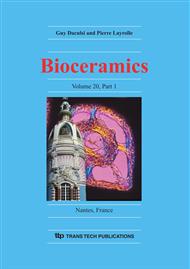p.1165
p.1169
p.1173
p.1177
p.1181
p.1185
p.1189
p.1195
p.1199
In Vitro Studies of Cell Growth on Three Differently Fabricated Hydroxyapatite Ceramic Scaffolds for Bone Tissue Engineering
Abstract:
The aim of this study is to analyse the influence of differently fabricated HA-scaffolds on bone marrow stromal cells. Therefore, three methods were used (a polyurethane (PU)-replica technique, the dispense-plotting and a negative mould technique) to produce porous hydroxyapatite (HA) ceramics. The different HA-scaffolds were then cultivated with an osteoblastic precursor cell line. In our study, highest cell proliferation and differentiation was achieved by using (PU)-replica technique. However, this study shows also that all three types of scaffolds are suitable for tissue engineering applications and as bone substitute material. The knowledge about the influence of pore size and geometry on the cell behaviour will help to tailor scaffolds, by different 3D fabrication methods, for the needs of tissue engineering laboratories or patients.
Info:
Periodical:
Pages:
1181-1184
Citation:
Online since:
November 2007
Authors:
Keywords:
Price:
Сopyright:
© 2008 Trans Tech Publications Ltd. All Rights Reserved
Share:
Citation:


